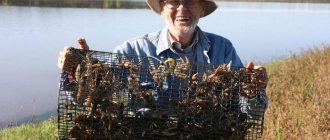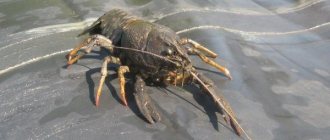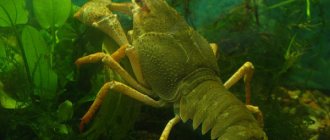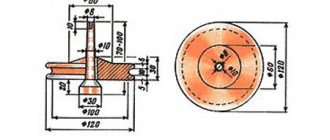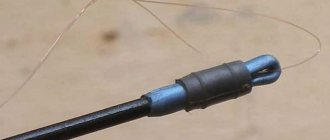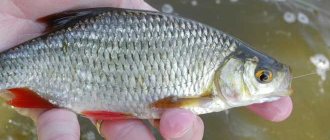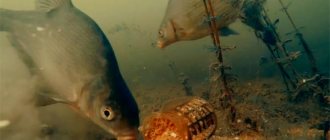Description and habitat
Crayfish live in clean running water - rivers, lakes, streams with a small current. Often during the daytime they hide under stones, tree roots, or in small burrows at the bottom of reservoirs. At night they crawl out to hunt. Crayfish are omnivores. Both plants and fauna can serve as food for them. Moreover, they eat both living and dead prey. Crayfish, unlike other representatives of predatory animals, do not kill their prey, but holding it tightly with their claws, bite off small pieces of it.
Crustacean representatives of the fauna live in reservoirs with a hard muddy bottom, at a depth of up to 3 meters.
Content:
- Description and habitat
- Composition and nutritional value
- Beneficial features
- Hazardous properties
- Use of cancer in medicine
- Use in cosmetology
- Cancers for weight loss
- conclusions
The crayfish is dressed in a hard chitinous shell that covers its soft parts of the body. It has a greenish-brown color, which remarkably protects it from dangers at the bottom of the reservoir, making it invisible. The body of a crayfish consists of two parts: the cephalothorax and abdomen. The arthropod abdomen consists of 5 pairs of limbs that allow the crayfish to swim. And the sixth and seventh pairs form the caudal fin. The organs of touch and smell in crayfish are movable antennae located in the head section. Several pairs of limbs extend from the chest: the first three pairs are used for grabbing food, then the claws follow, and the remaining 4 pairs are used for movement. The crayfish's gills are located in gill chambers, covered from the internal organs by body integument, and from the environment by a durable chitinous shield.
Crayfish and catching crayfish
- VK
Crayfish (Astacus astacus), or common crayfish, belongs to the order of decapod crustaceans (Decapoda). The front pair of limbs is highly developed and ends with claws, with which the crayfish grabs prey and defends itself. The next four pairs of less developed limbs are designed for movement.
Under the tail shell there are five more pairs of short atrophied limbs. The anterior pair is developed in males into long tubular genital organs. In females, the corresponding limbs are almost completely atrophied. The sex of young crayfish can be visually determined only by the presence or absence of tubular genital organs. The sex of adult crayfish is determined more easily by comparing their claws and tails: males have larger claws, and females have a wider tail than individuals of the opposite sex. The female's wide tail protects the eggs while they, attached to short limbs, develop under the tail. The genital opening in females is located at the base of the third pair of limbs, and in males - at the base of the fifth pair of limbs. Content:
- HABITAT AND LIFESTYLE
- HEIGHT
- MOLTING
- REPRODUCTION
- NUTRITION
- ENEMIES OF CANCER
- CRASH CATCHING
- CRASHBEATING
- HOW AND WHERE TO CATCH CRASHES
- STORAGE AND TRANSPORTATION OF CRASHFISH
HABITAT AND LIFESTYLE
Cancers are more picky about their environment than many people think. The water where they live must be fresh; crayfish cannot reproduce in salt or salt-fresh sea water. Crayfish need the same oxygen content in water as salmon fish. For normal life of crayfish in the warm season, the water must contain oxygen above 5 mg/l. Crayfish can live in both light and dark water, as long as it does not have too much acidity. The pH value of ideal water for crayfish should be above 6.5. The growth of crayfish in waters depleted of lime slows down. Crayfish are very sensitive to water pollution. If living conditions are favorable, then crayfish can live in a wide variety of fresh water bodies - lakes, rivers, oxbow lakes and streams. However, it seems that the favorite habitat of crayfish is still rivers.
In crayfish habitats, the bottom of the reservoir should be solid and free of silt. On a muddy bottom, as well as on rocky or sandy shores, as well as in shallow water with a flat, clean bottom, crayfish are not found, since they cannot find shelter for themselves or dig it out. Crayfish love rocky bottoms where they can easily find shelter, or bottoms suitable for digging holes. Crayfish burrows are found in coastal holes or on coastal slopes. Most often they are located on the border of a hard and soft bottom. The exit from the burrow, the corridor of which can be more than a meter long, is usually hidden under the trunk of a fallen tree, tree roots or under stones. A crayfish's burrow is quite narrow, dug according to the size of the inhabitant, which makes it easier for crayfish to organize protection from attacks by larger brothers. It is difficult to pull the crayfish out of the hole; it tenaciously clings to its walls with its limbs. That the hole is inhabited is indicated by fresh soil at the entrance. Cancer lives at a depth of 0.5 to 3.0 m. The best places for housing are captured by large males, less suitable ones are left for weak males and females. Juveniles stay in shallow water near the very shoreline, under stones, leaves and twigs.
Cancer by its way of life is a hermit. Each individual has some kind of shelter that protects it from its relatives. During daylight hours, the crayfish is in a shelter, closing the entrance with its claws. Sensing danger, he quickly backs away, going deeper into the hole. The crayfish comes out to search for food at dusk, and in cloudy weather - in the afternoon. It usually moves in the water at night with its claws extended forward and its tail held straight, but if startled it will quickly swim back with the help of strong tail strokes. It is usually believed that cancer stays in one place. However, after a few weeks, tagged crayfish end up in gear hundreds of meters from the places where they were tagged.
HEIGHT
The growth rate of crayfish depends primarily on the temperature and composition of the water, the availability of food and the density of crayfish in the reservoir. The growth rates of crayfish in different reservoirs are different. But even in one body of water it is not the same from year to year; much depends on the temperature of the water. In the first and second summers of life, males and females have the same growth rate, but at the end of the third summer, or second year of life, males are on average larger than females. In the conditions of southern Finland, crayfish reach a length of 1.4–2.2 cm by the end of the first summer, 2.5–4.0 cm by the end of the second summer, and 4.5–6.0 cm by the end of the third summer. Minimum Males reach the permitted size for fishing (10 cm) at 6-7 years of age, females at 1-8 years of age. In waters with sufficient food for crayfish and under other favorable conditions, crayfish can reach the size allowed for fishing two years earlier than the specified period, but under unfavorable conditions - several years later.
People often ask how big crayfish can grow. Fisheries advisor Brofeldt noted in 1911 that in the town of Kangasala there were specimens 16-17 cm long, although later such crayfish were caught less and less often. Suomalainen reported that the 12.5-13 cm long crayfish caught in 1908 were medium-sized specimens. These evidences seem like fairy tales to us - crayfish do not have to be so large. In 1951, the magazine Seura organized a competition to see who could catch the largest crayfish over the summer. The winner was a participant in the competition who caught a crayfish 17.5 cm long, 28.3 cm to the tip of the claw, weighing 165 g. The crayfish had only one claw, which explains its relatively low weight. It can be considered a surprise that the giant crayfish turned out to be a female. In second place was a male, whose length was 16.5 cm, and to the tips of the claws - 29.9 cm. This specimen weighed 225 g. Other examples of caught crayfish with a length of 17.0-17.5 cm are known from the literature. It is interesting to note , that, according to the Estonian scientist Jarvekulgin, male crayfish over 16 cm long and weighing 150 g, and female crayfish over 12 cm long and weighing 80-85 g are exceptionally rare. Obviously, the female caught in Finland in 1951 can be considered a giantess.
How long do crayfish live? There is not yet a sufficiently accurate method for determining the age of crayfish, similar to how the age of fish is determined. The lifespan of crayfish individuals is forced to be determined by comparing age groups or groups of crayfish of the same length. Because of this, it is impossible to accurately determine the age of single large specimens. There is information in the literature about crayfish reaching 20 years of age.
MOLTING
Crayfish grow as if in leaps and bounds - as they replace their shells. Molting is an important moment in the life of crayfish; at this time, a thorough renewal of their organs occurs. In addition to the chitinous cover, both the upper layer of the retina and gills, as well as the protective upper layer of the oral appendages and parts of the digestive organs, are renewed. Before molting, the crayfish hides in its burrow for several days. But the molting itself occurs in an open place, and not in a hole. Replacing the shell only takes about 5-10 minutes. Then the defenseless cancer is huddled in a shelter for a week or two, while the shell hardens. At this time, he does not feed, does not move and, naturally, does not get caught in the gear.
Calcium salts enter the new shell from the blood and permeate it. Before molting, they accumulate in two oval solid formations located in the stomach of crayfish. Sometimes they can be detected when crayfish are eaten.
Molting occurs only in the warm season. In the first summer of life, the crayfish molts 4-7 times, depending on growth conditions, in the second summer - 3-4 times, in the third summer - 3 times and in the fourth summer - 2 times. Adult males molt 1-2 times a season, and females that have reached sexual maturity, as a rule, once. Closer to the northern border of the distribution of crayfish, some females molt every second year.
Molting of males, as well as females who do not have eggs under the tail, occurs at the end of June; females carrying eggs - only when the larvae emerge from the eggs and separate from the mother. In southern Finland, such females usually change their shells at the beginning of July, and in northern Finland their molting begins in August.
If the start of summer is cold, shedding may be delayed by several weeks. In such cases, when the fishing season begins (from July 21), the shell may not yet harden, and the crayfish will not be caught in the gear.
REPRODUCTION
Male crayfish reach sexual maturity at approximately 6-7 cm, females at 8 cm. Sometimes there are females 7 cm long, carrying caviar under their tail. Males reach sexual maturity at 3-4 years (corresponding to 4-5 year seasons), and females at 4-6 years (corresponding to 5-7 year seasons).
The sexual maturity of a crayfish can be determined by carefully lifting its dorsal shell. In a male that has reached sexual maturity, curls of white tubes are visible in the tail part under the thin “skin”. The white color of the tubes, which are sometimes mistaken for parasites, is given by the liquid in them. Under the shell of the female, eggs are visible, which range from pale orange to brownish-red, depending on the degree of their development. The sexual maturity of the female can also be determined by the white veins running across the lower shell of the tail. These are mucous glands that secrete a substance with which the eggs are then attached to the tail limbs.
Mating of crayfish occurs in the fall, in September-October. Crayfish do not gather, like fish, to spawning grounds; their fertilization occurs in their usual habitats. The male uses large claws to turn the female onto her back and attaches spermatophores at the female's genital opening in the form of a white triangular spot. A few days later, or even weeks, the female, lying on her back, lays eggs. The female usually lays from 50 to 150 eggs, and sometimes up to 400. The eggs are not separated from the female, but remain in a gelatinous mass secreted by her glands.
Under the female's tail, the eggs develop until the beginning of next summer. During the winter, the number of eggs is significantly reduced due to mechanical loss and fungal infection. In the southern regions, the larvae emerge from the eggs in the first half of July, in the northern regions - in the second half of July, depending on the water temperature at the beginning of summer. When emerging from the eggs, the larvae are already 9-11 mm long and are very similar to small crayfish. But their back is more convex and relatively wide, and their tail and limbs are less developed than those of young crayfish. The larvae stay under the mother's tail for about 10 days until they completely suck out the transparent reddish yolk. After this, they separate from their mother and begin an independent life.
NUTRITION
Cancer is an omnivore. It feeds on plants, bottom organisms, and even devours its relatives, especially those that are moulting or have just moulted and are therefore defenseless. But the main food is still plant food, or rather, in the first years of life, the crayfish feeds more on benthic organisms and gradually switches to plant food. The main food is insect larvae, especially mosquito larvae, and snails. Fledglings readily eat plankton, water fleas, etc.
The cancer does not kill or paralyze its prey, but, holding it with its claws, gnaws it, biting off piece by piece with the sharp parts of its mouth. A young crayfish can eat a mosquito larva several centimeters long for about two minutes.
There is an opinion that crayfish, eating eggs and fish, harms fisheries. But this information is based more on assumptions than facts. At the beginning of the current century, T. X. Yarvi pointed out that in those reservoirs where crayfish were released, the number of fish did not decrease, and in reservoirs in which the plague destroyed crayfish, the number of fish did not increase. Not a single one of the 1,300 crayfish from the two rivers caught by the research ate fish, although there was a lot of it and a wide variety of it. It's not that cancer can catch fish. Its slow movements are deceptive; it is able to quickly and accurately grab prey with its claws. The small portion of fish in the crayfish’s diet is apparently explained by the fact that fish simply do not swim close to the crayfish’s habitat. Cancer is certainly capable of eating sedentary, sick or wounded fish in large quantities and effectively clears the bottom of the reservoir of dead fish.
ENEMIES OF CANCER
Crayfish has many enemies among fish and mammals, although it is well protected by its shell. Eel, burbot, perch and pike readily eat crayfish, especially during their molting. The eel, which can easily penetrate the crayfish burrow, is the most dangerous enemy of large individuals. For young crustaceans living in coastal waters, the most dangerous predator is perch. Larvae and juveniles of crayfish are also eaten by roach, bream and other fish that feed on bottom organisms.
Among mammals, the most famous enemies of crayfish are muskrat and mink. In the feeding areas of these animals, near the shores of reservoirs, you can find quite a lot of waste from their food - crustacean shells. And yet, what destroys crayfish the most is not fish and mammals, but the crayfish plague. Crayfish diseases.
CRASH CATCHING
It is known that crayfish were caught already in ancient times. Until the Middle Ages they were used for medicinal purposes. It was recommended to sprinkle the ashes of live burnt crayfish on wounds from bites from rabid dogs, snakes and scorpions. Eating boiled crayfish was also prescribed for medicinal purposes, for example for exhaustion.
The crayfish fishing season in Finland begins on July 21 and lasts until the end of October. Starting from the second half of September, catches have been declining. In practice, crayfish fishing is stopped several weeks before the ban, since in late autumn the crayfish meat loses its taste and the shell becomes harder and harder.
Crayfish catches at the beginning of the season depend primarily on water temperature. If May and June are warm and the water temperature remains high, then the molting of both males and females ends before the onset of the fishing season. In this case, the catches are good from the very beginning. In cold summers, molting may be delayed, and crayfish begin to move after the shell hardens only at the end of July.
Due to the expansion of net fishing, other methods of catching crayfish remain in the background or are completely forgotten. And yet, crayfish can be caught in different ways, which are not so easy, but are excitingly interesting for amateurs.
Hand catching
Catching crayfish with your hands is the most primitive and, apparently, the most ancient method. The catcher moves carefully in the water and looks under stones, tree trunks, and lifts the branches under which the crayfish hide during the daytime. Having noticed the crayfish, he tries to quickly grab it until it hides in a shelter or runs away. Naturally, this fishing method is not suitable for those who are afraid of claws. The biggest catch happens in the dark, when crayfish emerging from their shelters can be caught by illuminating the bottom of the reservoir with a flashlight. In the old days, a fire was lit on the shore to attract crayfish. In this simple way, near the shore on a rocky bottom, where there are many crayfish, you can catch hundreds of them.
You can grab a crayfish with your hands only if the water depth is no more than 1.5 m. To catch crayfish in deeper waters, and in reservoirs with light water at a depth of even several meters, so-called crayfish mites were used in Finland. These wooden pincers are used to easily catch and lift crayfish from the water. Ticks can be from one to several meters long. To prevent the pincers from damaging the crayfish, they can be made hollow.
A simpler device is a long stick, at the end of which a split is made, and it is expanded with the help of a small stone or a wooden stick. It is impossible to pull a crayfish out of the water with such a stick; it is only pressed to the bottom and then lifted by hand. Fishing with ticks requires great skill, since crayfish, as soon as they sense danger, run away very quickly. Due to their own slowness, the Finns did not widely use pincers as a fishing tool, and they did not become widespread. The unpopularity of this fishing method... apparently, it is also connected with the fact that in the dark waters of Finnish reservoirs it is difficult to notice the crayfish, and if the reservoir is a little deeper than a very shallow one, then it is completely impossible to see it.
This method of catching crayfish also includes underwater fishing. It requires special glasses and a breathing tube. Crayfish can be pulled out of holes with gloved hands or collected from the bottom at night. When diving at night, you need to have a flashlight, or your partner should illuminate the bottom from the shore or boat. Although a diver fishes close to the shore, various dangers always await him. Therefore, it is recommended that a partner be on duty on the shore and monitor the progress of fishing.
Rachevni
Nowadays, ranches have begun to be widely used. The rachevnya is a cylindrical mesh stretched over a metal round hoop. Hoops are currently made from galvanized wire. Previously, they were made from willow or bird cherry twigs and a stone, piece of iron or a bag of sand was tied in the center of the mesh for bracing.
The diameter of the hoop is usually 50 cm. Three or four thin cords of the same length are tied to the hoop at an equal distance to avoid skewing of the rope, and they are connected with a common knot, into the loop of which a stronger cord is threaded to lower and raise the tackle. If fishing from the shore, the cord is attached to a pole. The bait is tied to a net, a cord stretched across the diameter of the hoop, or a thin stick also attached to the hoop, and the trap is lowered to the bottom. The cord for pulling out the rachen is tied to a buoy or pole stuck into the bank slope. Fishing with crayfish is based on the fact that a crayfish that has grabbed the bait cannot get out of the trap when it is lifted from the water. You should lift the rack without delay. At the same time, you can fish with several crayfish, placed at a distance of 5-10 m from each other. Crayfish nets.
CRASHBEATING
With the fishing methods considered, no bait is used at all. The catch when fishing without bait always depends on chance, and there is no guarantee that you will catch crayfish. With the use of bait, fishing becomes more effective. The bait attracts the crayfish to the gear and keeps it in the fishing areas.
The crayfish gathered around the bait can be taken with your hands or with a net. But a more “improved” fishing method is fishing, in which the crayfish clings to a bait tied to the end of a fishing line or the base of a stick, and holds on to the bait until it is caught with a net and pulled out of the water. Fishing for crayfish differs from fishing for fish in that they do not use hooks and the crayfish can unhook at any time.
A fishing line is tied to a 1-2 m long stick, and bait is tied to the fishing line. The pointed end of the stick is stuck into the bottom of a lake or river near the shore or into the coastal slope. The bait is placed in the right place to attract the crayfish.
A fisherman can use several, even dozens, fishing rods at the same time. Their number depends primarily on the density of crayfish in the reservoir, the activity of their feeding and the supply of baits. According to Swedish researcher S. Abrahamsson, the bait attracts crayfish in stagnant water from an area of about 13 sq.m. Therefore, there is no point in placing gear more often than at a distance of 5 m from each other and no closer than 2.5 m from the coastline. Typically, fishing rods are stuck at a distance of 5-10 m from one another, in more catchy places more often, in less catchable places - less often.
During the evening and night, depending on the food, the fishing rods are checked several times, sometimes even 3-4 times an hour. The fishing area should not exceed 100-200 m in length so that the fishing rods can be checked in time before the crayfish have time to eat the bait. If the catch decreases during the evening, you need to move to a new place. When checking fishing rods, carefully pull the stick out of the bottom and lift the fishing rod so slowly and smoothly that the crayfish that has grabbed the bait does not unhook, but rises with it closer to the surface of the water, where the prey is picked up from below with a net carefully lowered into the water. Fishing can be very effective. Sometimes you can pull out 10-12 crayfish at a time. The swaying end of the stick to which the fishing line is attached indicates that the crayfish has attacked the bait,
The zakidushka and the zherlitsa are the same type of tackle as the fishing rod. In them, a bait is usually tied to a 1.5-meter long fishing line, and a float is tied to the other end. A sinker is tied to the rod next to the bait.
The so-called crayfish stick differs from a fishing rod in that a short piece of fishing line is tied to the stick or no fishing line is used at all. In this case, the bait is attached directly to the lower end of the stick. The stick is stuck into the bottom of the fishing area so that the bait is freely lying on the bottom.
The technique of fishing with a zakidushka, a zherlitsa and a crayfish stick is the same as fishing with a fishing rod. Crayfish are fished with all these gears in the same way as fish. The angler holds the rod in his hands all the time and, feeling that the crayfish has grabbed the bait, carefully pulls it along with the bait to the surface of the water, closer to the shore, and with the other hand places the net under the crayfish. They fish this way, for example, in France - there they tie a ring to the end of the fishing line to thread bait through it.
HOW AND WHERE TO CATCH CRASHES
For good crayfish catches, you need to know how and where to catch them. The mobility of crayfish depends on the illumination of the water. In dark waters that do not transmit light well, the tackle can be placed early in the evening, sometimes as early as 3-4 p.m. The richest catch in such waters is in the evening, and by midnight it decreases, as the activity of crayfish decreases. In clear waters, you should not start catching crayfish before evening; the catch continues to grow until midnight and even after midnight. After the darkness of the night, a new zhor is noted, but it is weaker than the evening one.
Many other factors also influence the movement activity of crayfish. In cloudy weather you can start fishing earlier than in clear weather. The best crayfish catches occur on warm, dark nights and also in rainy weather. Catches are poorer on cold, foggy and bright nights, as well as during moonlight. Thunderstorms also interfere with fishing.
Traps are usually placed at a depth of 1-3 m, but if the vegetation eaten by crayfish and the bottom suitable for their habitat are in deeper places, you can try to catch at a depth of several meters. Crayfish stay deeper in light water than in dark water. It is best to catch them in reservoirs with a rocky or pebble bottom, near abandoned stone piers, bridges, under snags, near steep banks and under bank slopes from a bottom suitable for digging holes.
At night, during fishing, crayfish are not measured or sorted, since in the dark this takes a lot of time and slows down the fishing. Collect crayfish in a bowl with low, steep edges and a wide bottom so that they are not placed in a thick layer. There should be no water at the bottom of the dish.
It is very convenient to measure the length of the crayfish with a measuring stick, which has a recess in the shape of the back of the crayfish. The length of the stick is 10 cm. Young crayfish less than 10 cm in size are selected and released back into the water. It is recommended to release them into the water away from the fishing site so that they are not caught again and are not needlessly injured.
STORAGE AND TRANSPORTATION OF CRASHFISH
Most often, caught crayfish must be stored for some time before consumption. They are usually stored in cages. It must be borne in mind that in order to localize possible infectious diseases, crayfish in cages should be kept in the reservoirs from which they were caught. Low boxes made from boards with holes drilled in the walls, or boxes with slots, have proven themselves best as cages. Crayfish are well preserved in cages made of wooden planks or metal mesh.
Crayfish should be kept in cages for as little time as possible, since they eat each other, especially helpless individuals. When storing crayfish for more than 1-2 days in cages, they need to be fed so that they are better preserved and less likely to attack one another. The usual food is fresh fish. Crayfish can also be fed with nettles, alder leaves, potatoes, pea stems and other plant foods. It has been noticed that crayfish fight more often for fish than for plant food. In these fights, they lose their claws and suffer other injuries. To avoid this, it is better to feed crayfish with plant foods in cages.
Crayfish are usually transported without water, in spacious boxes. Wicker baskets are especially practical, as are wooden, cardboard and plastic boxes, as long as they have enough air holes.
Crayfish are placed in boxes about 15 cm high in only one row. It is recommended to lay a layer of damp moss, grass, nettles, aquatic plants, etc. on the bottom of the boxes, as well as on top of the crayfish. In higher boxes, intermediate shelves are made from slats so that the layers of crayfish do not fit tightly to each other. They can be transported safely and without intermediate partitions, layered with layers of damp moss. You need to put crayfish in boxes and cover them with moss as quickly as possible, before they start to move. If the crayfish begin to become active, they will quickly gather in heaps in the corners of the box. You need to be careful that the crayfish do not become covered with water that has collected at the bottom of the box.
When transporting crayfish in the summer heat, it is necessary to ensure that the temperature in the boxes does not rise too high. To do this, you need to cover the boxes from direct sunlight, place bags of ice around the boxes, etc. In hot weather, it is better to transport crayfish at night. To maintain the desired temperature inside, the outside of the boxes can be lined with any dry material.
According to the recommendation of the Germans, crayfish should be allowed to dry for half a day after being caught before being placed in boxes. There is also an opinion that crayfish tolerate transportation better if they have not received food for some time before.
The main measures for caring for crayfish in natural reservoirs are: - elimination of crayfish diseases, especially crayfish plague; — compliance with recommendations for catching crayfish; — crayfish transplantation; — reduction in the number of weed species in the reservoir; — improving the habitat of crayfish.
The duty of every crayfish catcher is to help localize the epidemic, prevent it from spreading widely, and follow the recommendations developed for these cases.
Intensive fishing for crayfish is one of the effective methods of increasing the number of crayfish in a reservoir. Since crayfish reach sexual maturity already at a length of 7-8 cm, and the minimum size allowed for catching crayfish is 10 cm, mass catching of crayfish will not harm their population in the reservoir. On the contrary, when large and slow-growing individuals that occupy the best habitats are removed from the reservoir, the reproduction of crayfish accelerates. Females with eggs and crustaceans should be immediately released into the water. Crayfish dishes
Individuals 8–9 cm long that have reached sexual maturity are suitable for dispersal. Resettlement should be carried out in August at the latest, so that the crayfish have time to acclimatize to the new habitat before mating begins and the onset of winter.
Related articles:
Fishing for bream on the current
Crayfish borders
Fishing in the city
Trout fishing on paid reservoirs
Composition and nutritional value
Crayfish meat is a very healthy and nutritious product. It contains a large amount of protein - about 16 g, and at the same time has an absolutely small amount of fat - only 0.95 g. This product is easily absorbed by the body and has a fairly low calorie content - only 76 kcal. Due to this, crayfish are a highly sought-after food in the dietary sphere. Crustaceans also contain quite a lot of water - 82.24 g, a little more than 1% carbohydrates, a considerable amount of organic acids and various minerals. Crayfish meat is enriched with calcium, magnesium, chromium, phosphorus, potassium, sulfur, cobalt and fluorine. It is dominated by B vitamins, as well as vitamins C and E, due to which crayfish have antioxidant and restorative properties and strengthen the body after illness. Cancer contains a large dose of iodine, so it is recommended to take it to prevent thyroid problems. But there is no harmful cholesterol in crustacean meat.
Beneficial features
Crayfish meat has been eaten for a long time. Most of it is contained in the abdomen of the crayfish and very little in the tentacles. They are boiled, salted, lightly crushed with parsley or dill and served. During heat treatment, crayfish acquire a rich red color due to the numerous carotenoids they contain. This is where the phraseological phrase “Red like a lobster” came from. After all, crayfish are initially a completely different color, and at the time of cooking they suddenly turn red.
Crayfish are famous for their wonderful taste. Their meat is very nutritious due to the fact that it contains a large amount of protein. Crayfish are rich in calcium, which has a beneficial effect on the condition of the skin, hair and nails, and iodine, which is necessary for the prevention of thyroid diseases. It is recommended to use them for those who have problems with the cardiovascular system and liver. This product contains a very small amount of fat, while being low in calories - this is just a godsend for those who want to lose weight. Crayfish meat speeds up metabolism and fills the body with vigor and energy. And the chitinous shell is successful in folk medicine due to its antiseptic properties. It has also been proven to have the ability to heal wounds.
Use in the food industry
Since ancient times, crayfish have been widely used as human food. Remains of crayfish shells were found in the so-called “kitchen heaps” of the Neolithic. Basically, crayfish are processed by boiling in salted water, and having acquired a peculiar red hue and an appetizing smell, they are served to the table, seasoned with herbs (dill, parsley, celery, etc.). When crayfish (and crustaceans in general) are cooked, they turn red. The change in color of crustaceans is explained by the fact that they contain a very large amount of carotenoids. The most common pigment found in the integument of crustaceans is astaxanthin
, in its pure form having a rich bright red color. Before heat treatment, and in live crayfish, carotenoids are combined with various proteins, and the color of the animal is usually bluish, greenish and brown. When heated, carotenoid and protein compounds easily disintegrate and the liberated astaxanthin gives the animal’s body a rich red color. The main volume of nutritious meat of crayfish is in the abdomen, and a slightly smaller amount is in the claws. Crayfish meat is white with sparse pink streaks, nutritious and has an excellent taste. In composition, it contains a large amount of protein and low fat content. The percentage of crayfish meat volume in comparison with other crustaceans eaten by people, it becomes obvious that crayfish is not a record holder, although it exceeds a number of food crabs. In other words, there is little meat in an adult crayfish. If a kilogram of whole shrimp contains about 400 grams of meat, then a kilogram of crayfish contains barely 100-150 grams (abdomen and claws), while crayfish are approximately 3-4 times more expensive. Probably the consumption of crayfish itself is mainly based on the rather attractive appearance of all kinds of dishes decorated with boiled crayfish, and partly by long-standing traditions.
Hazardous properties
Crayfish meat is a rather allergenic product, and therefore it is recommended to use it with great caution, especially for people prone to allergies. Also, people who have problems with the thyroid gland should not abuse crustaceans. Although, it would seem that cancer is so rich in iodine that this should, on the contrary, have a positive effect on the course of the disease. But doctors especially emphasize the fact that iodine-rich cancer meat can only be used to prevent the problem. It is not used to treat the disease.
Improperly prepared crayfish can cause gastrointestinal problems and dangerous poisoning. It must be remembered that only fresh product is suitable for cooking in order to avoid undesirable consequences. It is necessary to observe not only the correct cooking process, but also the storage of crayfish meat. It is better to store the product in glass containers, since the sulfur in its composition does not allow the use of metal products for this. Upon contact with it, the meat of crustaceans turns black and quickly deteriorates.
Use of cancer in medicine
Crayfish is widely used as a restorative and rehabilitative agent in modern and folk medicine. Due to the fact that its shell consists of chitin, a rich source of chitosan, it has the ability to remove radionuclides and heavy metals from the human body. Therefore, preparations from the chitinous plates of crustaceans are successfully used in people exposed to radiation or working in places where the radiation level exceeds the required standards.
Also, crustacean shells are often used for medical purposes for the manufacture of artificial skin, for the production of drugs that promote wound healing and high-quality treatment of scars, and also as suture material. Treatment with medications containing chitinous plates of crustacean shells is recommended for those who have undergone cancer surgery or undergone chemotherapy. The thing is that they contain precious calcium, which accelerates the regeneration processes of affected organs and tissues and contributes to the successful rehabilitation of patients. In addition, chitosan helps strengthen joints and is used to prevent arthritis and arthrosis.
As mentioned above, crustacean meat is characterized by a high iodine content. In addition to the fact that eating crayfish will relieve problems with the thyroid gland, it will also have a positive effect on the growing body. After all, iodine is very important for children and adults, and is also necessary for pregnant women.
It should be used with caution during pregnancy and lactation, as well as in children's diets, as there is a risk of developing allergies.
It is also recommended to consume crayfish meat if:
- cardiovascular failure;
- kidney problems;
- diseases of the pancreas;
- diseases of the liver and biliary tract;
- digestive problems.
Crayfish in Germany
Specifically, the common European crayfish is currently the main object of research by scientists from Germany led by Dr. M. Keller. Most of them are unanimous in the opinion that a crayfish farming business can be extremely profitable. Despite the natural cannibalism that occurs between crayfish, significant success has been achieved in this direction to limit it. Numerous difficulties relating to their maintenance and transportation have been resolved, the creation of better conditions for their breeding in reservoirs has been carried out, and research and prevention of diseases and parasites inherent in crayfish have been carried out. Numerous experiments were also carried out to improve methods of fertilization, both natural and artificial.
Installation of closed water supply
The successful breeding of crayfish in Lake Rottach-speicher (Germany), the water surface of which is about 300 hectares, is indicative. It is worth noting that it was filled only in 1990, when 10 thousand crayfish fingerlings were released along with various types of fish. The entrepreneur who rented this lake began to harvest a large harvest of large males within two years and now has a solid business with volumes of about 50 tons. Some of the individuals that were released in 1990 were caught only ten years later, some weighing up to 250 grams.
It was in Germany that significant success was achieved in the field of crayfish breeding. The beginning was made in 1985 at one of the Bavarian enterprises specializing in crayfish breeding. A special installation with a closed water supply was created and successfully used. Its capabilities are not limited to the hatching of crayfish; it is successfully used for breeding young of the year. This installation allows hatching more than 150 thousand fry and 35 thousand fingerlings during the year. And although crayfish eggs are naturally fertilized at this plant, artificial insemination is also used in other German plants.
In this regard, great success has been achieved by specialists from one of the companies in Eversee. Initially, they borrowed the experience of Finnish crayfish farmers in the field of artificial insemination. Subsequently, a special installation was created to fertilize the eggs. It works according to the following scheme. The eggs of the females are scraped off and placed in baskets, in which they are continuously washed with water, simulating the process of natural fertilization under the female’s tail. This made it possible to almost double the fertilization rate of eggs compared to natural ones. It was also noticed that the larvae obtained in this way are more resilient than after hatching in females.
Almost all crayfish farmers in Germany are united in a union promoting the protection of crayfish in Europe. The Union often holds various forums and conferences where important issues are discussed and cancer farmers exchange experiences. In 2007, the 3rd forum dedicated to the protection of crayfish was held in Austria and a special booklet was published, in which not only the most interesting materials were published, but also important and useful recommendations on crayfish farming were given.
Use in cosmetology
In the field of cosmetology, crayfish are famous precisely because of the substance contained in the chitinous plates of their shell - chitosan. Preparations based on it have a beneficial effect on the skin: they protect against ultraviolet radiation and the negative effects of the environment. The fact is that chitosan, when applied, forms a thin, imperceptible protective film on the surface of the skin, which significantly reduces the process of evaporation of liquid from the skin. Therefore, the skin remains moisturized for a long time and is less susceptible to free radicals.
Cosmetic products containing elements of the chitinous cover of crustaceans are very valuable, as they consist of natural, environmentally friendly ingredients. Chitosan is easily absorbed by body cells and has absolutely no adverse effect even on sensitive skin. And since this component also has regenerating properties, it is very often used in the production of anti-aging cosmetics aimed at rejuvenating and restoring the structure of the skin. Preparations with chitosan are used in the production of masks, cosmetic peelings, lotions, creams and other products.
Crayfish habitat
Contrary to popular belief, crayfish are not so unpretentious in choosing a reservoir. Most of all, they like to settle in reservoirs with a hard and not very muddy bottom, preferring to be located at a depth of 1.5 to 3 m, at the bottom and in holes near the shore. Juveniles can be found in shallow water, a short distance from the coastline. In dense clay bottoms and on cliffs they are able to dig holes up to 1 meter deep, which are carefully guarded.
These animals cannot tolerate high levels of acidity; the ideal pH for their habitat should be 6.5 or higher. These crayfish cannot live in salty sea water. If there is a deficiency of lime in a reservoir, the crayfish living in this place will grow much more slowly. The most suitable water temperature for these inhabitants of freshwater bodies is 16-22˚С. They prefer to lead a nocturnal lifestyle, hiding under snags during the day, hiding at the bottom, in various depressions, or burying themselves in silt.
Cancers for weight loss
The dietary properties of cancer are influenced by three factors:
- low calorie content of crayfish meat;
- no fat;
- high protein content.
Many diets, especially protein ones, strongly recommend using crustacean meat in their menu. After all, not only is it a natural source of protein, but it also has such a low energy value. And the same notorious chitosan, which, among other things, also promotes the breakdown of fats and their removal from the body, is very widespread as a component of weight loss drugs.
